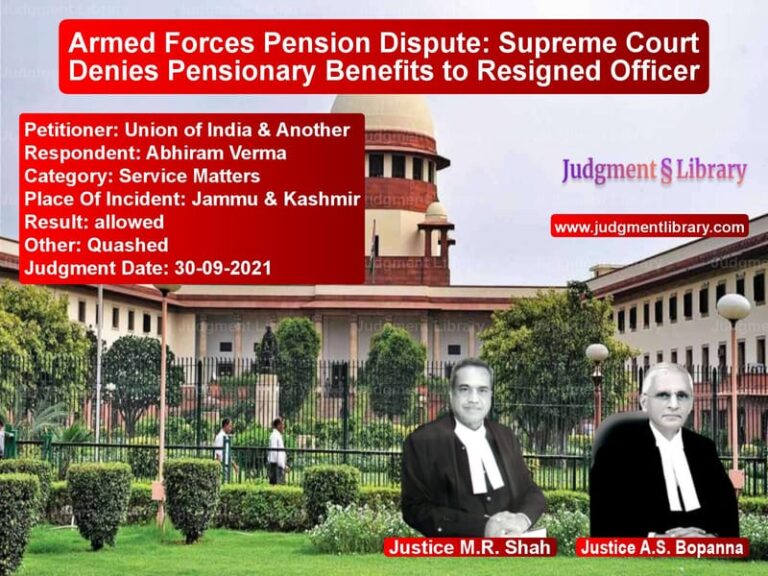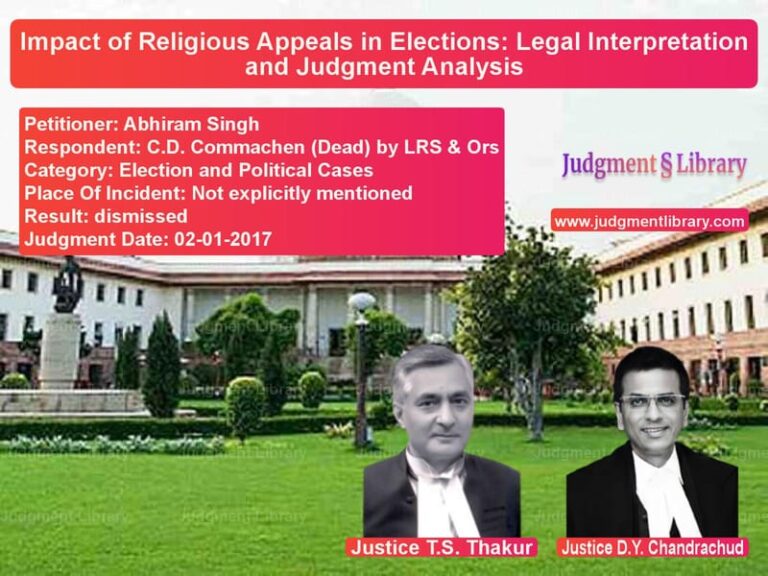Murder Conviction and Circumstantial Evidence: Legal Analysis in Domestic Homicide Case
This case revolves around the conviction of the appellant, Md. Anowar Hussain, for the murder of his wife, Samina Khatun, which was primarily based on circumstantial evidence. The appellant was accused of strangling his wife, leading to her death, and the case was presented before the Supreme Court after the appellant’s appeal was dismissed by the Gauhati High Court. The main issue in this appeal centers on whether the prosecution successfully established the chain of circumstances necessary to convict the appellant for the offence under Section 302 of the Indian Penal Code (IPC), based on the facts presented and the inferences drawn from the available evidence.
Background:
The deceased, Samina Khatun, had been married to the appellant for about three years. On October 22, 2010, her body was brought to the police station by her grandfather, Md. Akbar Ali (PW-1), who lodged an FIR claiming that the appellant had inflicted physical and mental torture on Samina, which culminated in her murder. The police registered the case under Sections 498-A, 302, and 120-B IPC, and after investigation, charge-sheeted the appellant for murder. The post-mortem examination revealed that the cause of death was asphyxia due to throttling.
The appellant denied the charges, claiming that his wife had died due to illness and was hospitalized before her death. However, the trial court found the appellant guilty of murder and sentenced him to life imprisonment. The appeal to the Gauhati High Court was dismissed, leading to the current appeal before the Supreme Court.
Appellant’s Arguments:
The appellant’s counsel contended that the prosecution’s case was based on circumstantial evidence and failed to establish the guilt of the appellant beyond reasonable doubt. The appellant argued that the testimonies of key witnesses, including PW-1 to PW-6, were inconsistent and that they suggested the deceased had died in the hospital due to illness. He further contended that the prosecution had not proven the motive for the murder or provided sufficient evidence to support the conviction. Additionally, the appellant argued that the medical evidence alone could not establish the cause of death as homicidal and that the absence of eyewitness testimony weakened the prosecution’s case.
The appellant’s counsel also highlighted the discrepancies in the police records, such as the timing and details of the arrest, the absence of a site plan with the charge-sheet, and the lack of any direct evidence linking the appellant to the crime scene. The counsel argued that these inconsistencies raised doubts about the validity of the prosecution’s evidence and that the conviction was based on mere suspicion, rather than solid proof.
Respondent’s Arguments:
The respondent, represented by the State, argued that the prosecution had established a strong case against the appellant based on circumstantial evidence. The respondent emphasized that the appellant’s wife was living with him at the time of her death and that the cause of death was asphyxia due to throttling, as confirmed by the post-mortem report. The State contended that the appellant had failed to provide a plausible explanation for the death, particularly given that the injuries on the deceased’s body were consistent with strangulation. The respondent also highlighted the appellant’s failure to explain the absence of any witnesses to the alleged hospital visit, and the fact that he was absconding after the incident, which further implicated him.
The respondent also pointed out that the inquest report, signed by multiple witnesses, contradicted the appellant’s defense that the victim had died from illness. Additionally, the respondent relied on the principle that when an accused fails to explain the circumstances surrounding the crime, it can be used as an additional link in the chain of evidence. The State argued that the concurrent findings of the Trial Court and the High Court should not be disturbed, as they had properly evaluated the evidence and concluded that the appellant was guilty of the murder.
Court’s Analysis:
The Supreme Court carefully examined the case, focusing on the circumstantial evidence presented by the prosecution. The Court acknowledged that in cases of circumstantial evidence, it is essential for the prosecution to establish a complete chain of events that point only to the guilt of the accused, leaving no room for reasonable doubt. The Court noted that the medical evidence, including the post-mortem report, conclusively established that the cause of death was asphyxia due to throttling, which was consistent with the prosecution’s theory of murder.
The Court also addressed the appellant’s defense, emphasizing that the inconsistencies in the testimonies of the defense witnesses, who suggested that the victim died due to illness in the hospital, were unsubstantiated. The Court found that the inquest report, prepared at the police station, was a crucial piece of evidence, and the testimony of the investigating officer (PW-7) corroborated the circumstances surrounding the death. The Court further noted that the appellant’s failure to provide a plausible explanation for the cause of death or to account for his whereabouts during the time of the crime weakened his defense.
Judgment:
The Supreme Court upheld the conviction of the appellant, dismissing the appeal. The Court found that the prosecution had successfully established the guilt of the appellant beyond reasonable doubt, based on the circumstantial evidence, including the post-mortem report, the inquest report, and the appellant’s failure to provide a satisfactory explanation for the death. The Court held that the appellant’s conduct, including his absence from the scene of the crime and his subsequent flight, further supported the conclusion that he was guilty of murder.
The Court also rejected the appellant’s argument that the lack of motive should have led to his acquittal, stating that the absence of motive does not negate the guilt of the accused in a case based on circumstantial evidence. The judgment reaffirmed the principle that when the prosecution has proved a complete chain of circumstances, the accused’s failure to explain the situation can be considered as an additional link in the chain of evidence, leading to a conviction.
Conclusion:
This case underscores the importance of circumstantial evidence in criminal trials, particularly when direct evidence is unavailable. The Court’s decision highlights the need for the prosecution to establish a clear and unbroken chain of events leading to the guilt of the accused, and the role of the accused’s failure to explain incriminating circumstances in strengthening the prosecution’s case. The judgment serves as a reminder that a conviction based on circumstantial evidence can be sustained when the facts point conclusively to the guilt of the accused, and when the accused fails to provide a reasonable explanation for the crime.
Petitioner Name: Md. Anowar Hussain.Respondent Name: State of Assam.Judgment By: Justice Dinesh Maheshwari, Justice Aniruddha Bose.Place Of Incident: Goalpara, Assam.Judgment Date: 13-10-2022.
Don’t miss out on the full details! Download the complete judgment in PDF format below and gain valuable insights instantly!
Download Judgment: md.-anowar-hussain-vs-state-of-assam-supreme-court-of-india-judgment-dated-13-10-2022.pdf
Directly Download Judgment: Directly download this Judgment
See all petitions in Murder Cases
See all petitions in Bail and Anticipatory Bail
See all petitions in Fraud and Forgery
See all petitions in Judgment by Dinesh Maheshwari
See all petitions in Judgment by Aniruddha Bose
See all petitions in dismissed
See all petitions in supreme court of India judgments October 2022
See all petitions in 2022 judgments
See all posts in Criminal Cases Category
See all allowed petitions in Criminal Cases Category
See all Dismissed petitions in Criminal Cases Category
See all partially allowed petitions in Criminal Cases Category







